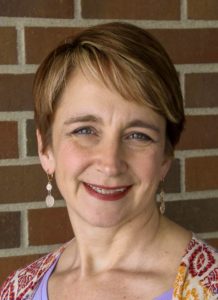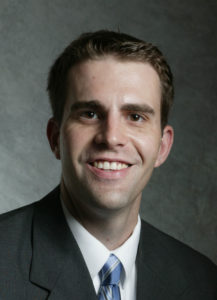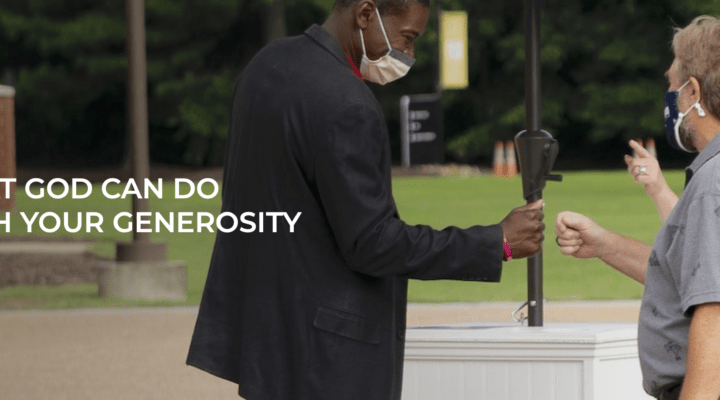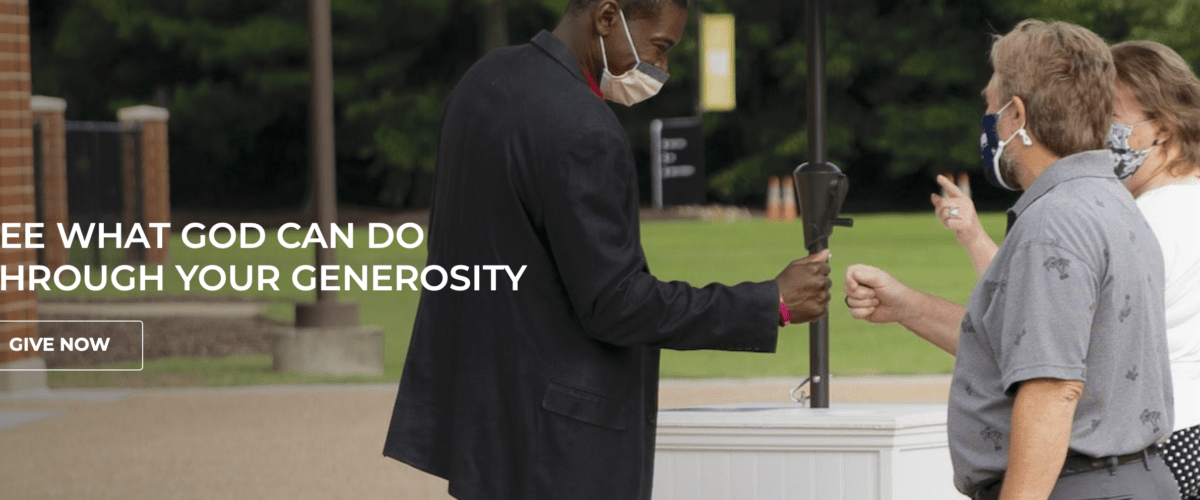Eleven months after the global COVID-19 pandemic forced the closing of churches and synagogues nationwide, faith communities of all stripes have stepped into the new year with new goals and expectations for how to fund and conduct their ministries and missions.
A survey conducted by The Church Network, an inter-denominational association of church business administrators, reveals that comparing 2020 to 2019:
- 46% of survey congregations said their 2020 income exceeded 2019.
- 13% said their 2020 income matched 2019.
- 36% said their 2020 income was no more than 10% less than 2019.
- 5% said their 2020 income was greater than 10% below 2019.
Additionally:
- 80% said 2020 income covered 2020 expenses.
- 48% said their 2021 spending plan is equal to or greater than 2020.
- 46% said their staff is receiving a pay increase in 2021.
- 3% said their staff is having a pay reduction in 2021.
Phill Martin, CEO of the network, said that while the survey is not a large sampling, it’s reflective of what he’s been hearing in conversations with members.

Phill Martin
“It’s a mixed bag. A lot of people are doing really well, some people are doing exceptionally well, and then some are just sort of OK,” he said. “More anecdotally, from everything I’m hearing, the worst-case scenario that everyone feared did not happen, and overall churches are doing well in light of the pandemic. I do think it’s true that there is an acceleration of trends that already were in place. Churches that already were struggling and really not prepared for the future are seeing their struggle and decline move faster. Churches that were solid and stable and had infrastructure in place are weathering it better.”
Allen Walworth, executive vice president of Generis, financial consultants to churches and nonprofits, said his organization has seen about one-third of churches actually exceed their expenses for the year and end the year with a surplus. Another third to maybe half were within 10% either above or below annual expenses.
“Now, there were about a third — it may not be any fault of their own, just the demographics of the church — that really struggled,” he said. “It especially was true if there already was some conflict in the church, or if you had a younger demographic or if you had a smaller church.”
He explained that some smaller churches were hit harder because they didn’t have the technological tools or the capital to purchase those tools to keep their congregations connected.
“When they didn’t have ways of beaming worship in a really effective and excellent way, it began to erode the connections with the congregation and limit other ways to stay in touch,” he said.
 At the other extreme were up to 15% of congregations that closed out the year 15% or more above their budget and not just above their expenses.
At the other extreme were up to 15% of congregations that closed out the year 15% or more above their budget and not just above their expenses.
“There’s like 15% of churches that say this is the best, strongest financial giving year we’ve ever had as a church, and no one saw that coming in March,” Walworth said. “Everybody had less expenses because there were programs that didn’t happen, but there were some who saw such a surplus that it allowed them to be much more innovative and more mission- and outreach-oriented and to do some things that wouldn’t even have been on their plate. That wasn’t widespread but it was a pretty noticeable amount.”
Growth for a multi-campus Carolinas church
Among churches engaged with The Church Network, the multi-campus, nondenominational Seacoast Church in the Carolinas saw unrestricted giving increase by about 5% in 2020 compared to 2019.
“That’s lower than what we’d typically see in a given year in terms of growth, although it’s hard to know what the year would have been like without the pandemic,” said Glenn Wood, pastor of administration. “We probably did better than most. There are some that had tremendous growth, but there’s a lot of them that had lots of challenges with dealing with decreased giving and decreased attendance last year.”

Glenn Wood
Seacoast has 12 campuses in South Carolina, one in North Carolina, and an online campus. Before the pandemic, the church had about 15,000 “attenders” at all locations combined — ranging from 6,000 at the founding location in Mount Pleasant, S.C., to 80 in the fishing village of McClellanville, S.C.
Wood said all the Seacoast campuses were closed for 182 days from mid-March to mid-September. All have reopened in accordance with parameters and metrics in their specific locations, with attendance across the board at about 55% of pre-COVID numbers. Harnessing technology to engage attenders and provide means of online giving have been key to keeping the church financially sound, he added.
“One of the things over the last few years and especially in 2020 is we have worked very hard at trying to basically tell the story of life changing through the church and through the gospel,” Wood said. Those stories gathered from within their membership and shown through videos and in sermon topics have spanned the full range of human challenges — from the pandemic itself to family and marital issues to personal financial difficulties.
Seacoast has had an online presence for 12 years, “so when the pandemic hit and we had to move everything online for services, it wasn’t a significant change for us,” Wood noted. “Now we did tweak the format and all, but we had a significant presence already, and I think that’s helped us especially continue to keep our attenders engaged in the church and engaged with the church. Along the same lines, we also moved the small groups online. I think that was and still is a challenge for some churches that didn’t have much of an online presence. They’re having to scramble to figure out, ‘How do we do it?’ One of the things we’ve realized even prior to the pandemic is ministering online is similar but also different than how you minister in person.”
Wood said Seacoast stopped passing offering plates and began collecting gifts through offering boxes about 15 years ago, but they’ve also introduced alternate ways of giving online. “A lot of people already were comfortable with those, and I think that also helped support the church as we had to move to being totally remote.”
Shift to online giving
Lutheran Church of the Cross in the Des Moines suburb of Altoona saw its giving increase by 5.9% in 2020 compared to 2019, according to Laurel Swanson, administrator/communication coordinator. Membership is around 1,000, with a pre-COVID attendance of around 650 and a current in-person attendance of 250, or 40%.
“We had a solid online giving group prior to the pandemic,” Swanson said, explaining that online giving has increased from 34% to 70% of total receipts through the pandemic. “I feel we made a conscious effort to let people know throughout 2020 how we continued to be able to bless our congregation and community with their generosity. Every week we were saying thank you and sharing an example or story.”

Laurel Swanson
Swanson said it was a “God-timing thing” that the church underwent a congregation-wide financial study — called “Balanced” — in January and February of 2020, “which I think helped people get their finances aligned with biblical principles prior to the pandemic hitting.”
Justin Greene, chief financial officer at Liberty Live Church in Hampton Roads, Va., said there was an immediate impact on giving with the mandatory closure of all their campuses.
“However, our members have continued to be faithful in their giving and we were able to close out 2020 meeting all financial obligations. From the expense side, we were able to reduce a portion of our operating costs (excluding personnel) simply by not being able to meet in person,” he said.
Liberty Live is a Baptist community with 11,390 members worshiping at six campuses in the Hampton Roads area and an online presence as well. Greene said two primary strategies have been the key to Liberty’s continued prospering through the pandemic.

Justin Greene
“The first strategy was already being well-established online. Having an online platform in place to easily migrate the congregation from in-person to online worship services allowed our congregation to never lose connection,” he said. “Additionally, a significant portion of our members already had adopted online giving as their method of giving.”
The second strategy was mobilizing their ministry team in the community.
“God opened doors for us to connect with and minister to hospital workers, first responders, schoolteachers and many others all across Hampton Roads in ways that we could not before,” Greene said.
Payroll help
For many congregations, loans through the Paycheck Protection Plan proved a help in getting through the year. According to a report in Newsweek magazine in July based on Treasury Department data, 88,411 churches received $7.3 billion in the first round of PPP loans.
Seacoast Church applied and received a PPP loan to maintain the employment of its 250-plus employees across all locations. With the buildings closed and many functions such as accounting moved off-site, employees have been put to work in different ways. For example, administrative and facilities staff helped with an outreach project to call all attenders twice so far during the pandemic.
With the buildings closed and many functions such as accounting moved off-site, employees have been put to work in different ways.
“Everybody is part of the gospel, and everybody is here to help,” Wood said. “We repurposed people as we could and found places for them to serve so that they could continue to be part of the solution and allow everybody to be employed.”
Lutheran Church of the Cross received a PPP loan as well.
“At the time we applied, we didn’t know we were going to have such a strong year,” Swanson said. “At this point, we are looking for ways to give away the amount we received from the PPP to bless our partner ministries.”
“Given the uncertainty of the financial climate in 2020, and based on conversations from sister churches, denominational leaders and legal counsel, we chose to receive a PPP loan,” said Greene at Liberty Live. “The loan enabled us to retain and provide support to all employees, even though our campuses were closed and all in-person events cancelled.”
Raising funds for the future
A church activity that for the most part ground to a halt in March is capital campaigns or special funding emphases, Walworth reported. While churches have rebounded with online services and the financial markets have recovered for the most part, “what we didn’t recover and have not yet is the ability to get people together in small groups and in public worship — the kind of ingredients it takes to build community, inspire vision and call people into a worshipful reflection of their gifts.”
Walworth said the only reason some campaigns did go forward was if there was a compelling situation like a debt balloon payment that was due or an opportunity to buy a property at a low cost. Otherwise, those kinds of campaigns were tabled. But now there is some movement and interest again.
“What we’re beginning to see is churches starting initiatives in the spring with the hope of culminating the campaign in the fall,” he said. “And an even larger number of churches are thinking about beginning in the fall and bridging over into the spring. For most people, next fall is beginning to feel like that’s when we can consider these things again.”
The view going forward
As 2021 unfolds, churches appear to be more optimistic than they were in early 2020 when the extent of the pandemic still was not known, Martin said.
Churches appear to be more optimistic than they were in early 2020 when the extent of the pandemic still was not known.
“I think two things are driving that,” he explained. “They’ve got this data under their belt, so they know what happened last year. And, the hope of the vaccine — although there’s some new anxiety related to it just because the rollout is so slow.”
At Seacoast Church, the outlook is “cautiously optimistic,” Wood said. “We still have not opened up every program at every campus and so as attendance continues to grow, we’re going to look at opening some of those. Financially, I think we are optimistic that things will improve, but again, timing wise, who knows? God is the only one who knows that.”
At Lutheran Church of the Cross, they’re expecting a “steady year” in 2021.
“Our congregation is excited with the ways we are ‘doing church,’ including several creative virtual connection points,” Swanson said. “Our theme is ‘Relationships, Rhythms and Risk / Sense of Adventure.’ It is exciting to see our congregation rally behind the many new things we are trying.”
Green at Liberty Live Church said there still is much economic uncertainty in 2021 but also opportunities.
“As with most organizations, the familiar way of operating changed almost overnight. Some impacts from the pandemic that we thought would be temporary are now looking more permanent. That means how we engage people and minister to them, how we steward resources and staff ministries, has needed to adapt to an ever-changing environment,” he said. “However, the new opportunities and new doors opened to us to share the gospel, doors that were tightly closed before the pandemic, gives us a lot of excitement and hope. We firmly believe God has positioned us, no matter how uncertain the times, to change lives, communities and the world for Jesus Christ.”
Still, questions remain
Looking ahead, there also are some questions about what church will look like when the doors are fully open again, Martin added.
“I think the uncertainty is not as much around finance as what does ministry look like going forward and how do you continue to do the virtual, online, creative stuff and everything else you were doing before,” he said.
David King, director of the Lake Institute on Faith and Giving at Indiana University’s Lilly Family School of Philanthropy, agrees there are many pressing questions going forward.
“Some congregations will revert back to what they’ve always done, and another third will use this as an opportunity to reflect on that new normal and redeploy their resources in different ways.”
“For the most part, I think this last year was about congregations streamlining expenses. Maybe they didn’t spend a lot of money on Bible school, they didn’t spend a lot of money on programming, they didn’t take mission trips, they didn’t travel. What will that look like in 2021? What is the expectation of a new normal?” he asked. “My guess is that some congregations will revert back to what they’ve always done, and another third will use this as an opportunity to reflect on that new normal and redeploy their resources in different ways.”

David King
King believes congregations are at an “inflection point” where they can think about their budgets not simply in terms of streamlining expenses but re-imagining how they do church.
“Religion has been a divisive force in our country in recent years and particularly in recent weeks. But at the same time, I think it holds the potential to be a great healer, convener and rebuilder of social trust,” he said. “It’s definitely true in local communities, and I think that’s one of the key values of congregations going into this next year.”
A big question for many churches is how they will approach having both an online experience and an in-person experience.
“How do you continue to resource a subset of one’s congregation that is not going to return, that is unable to return because they live two states away, or they’ve just grown accustomed to a different set of practices?” King wondered. “I think that’s going to be a both/and for many congregations, that if they don’t re-imagine that new normal, they’re going to be behind the eight ball.”
Walworth concurs.
“I’d say going forward it’s a pretty good likelihood that five years from now the church won’t snap back to what it was in 2019. I think there’s going to be a lot of people who got used to worshipping online, the church got good at offering it, and the churches will need to keep offering it,” he said. “But there are some people who probably got into Sunday morning tennis leagues, you know, who may not come back to worship, although there will certainly be more attending than there is now.
“But rather than that sounding like the most dire thing in the world, it is what churches have found who went to online worship: they found that actually their audience and reach greatly multiplied.”
Focus on mission and message
As always, a key to financial health will be making sure the mission and the message are clear.
“Congregations have to continue to make the case for why the support of individuals engaged in their community in a variety of ways is welcomed.”
“Congregations have to continue to make the case for why the support of individuals engaged in their community in a variety of ways is welcomed,” King advised. “Congregations will have to make the case for why they are good recipients for one’s gifts, tithes and offerings. If you don’t make that case regularly, you’re doing a disservice to your congregation’s future. And you may have to make it in a number of ways because you’ve got people who are engaging with you in ways that you wouldn’t have imagined before.”
Walworth said the good work of churches in 2020 during the pandemic sets a model for the future.
“Churches that really worked hard to keep expressing care and staying in touch because people weren’t coming to church, figuring out how to go to them electronically or in other old-school ways — those churches did better,” he said. “Churches that really stayed focused on their outreach innovation, especially with COVID-related things — here’s a poor neighborhood, kids are having to work from home who don’t have computers so let’s get them computers, or let’s help these frontline workers and have a ministry with them, or let’s work harder on affordable housing because some people are slipping below the poverty line because of COVID — when churches demonstrated that there’s never been a greater need for the church than in this dark hour, there was reason for people to keep giving.”
Jeff Hampton is a freelance writer based in Dallas.
Related articles:
Congregations on mission and online doing better financially amid COVID
Why live streaming, electronic giving may not save some churches
As major employers, churches help the economy with PPP loans
With five weeks remaining in this bizarre year, churches hope to finish well fiscally


